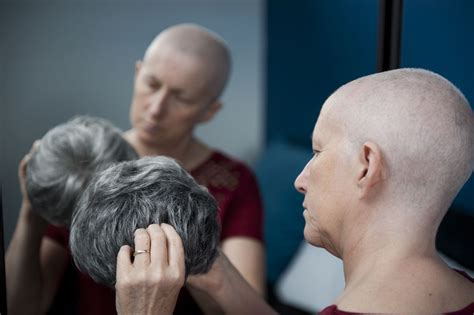Wigs for Cancer Sufferers: A Comprehensive Guide
Cancer treatments like chemotherapy and radiation can cause hair loss, affecting a patient’s physical appearance and emotional well-being. Wigs offer a solution to hair loss, providing comfort, confidence, and a sense of normalcy during a challenging time.

Benefits of Wigs for Cancer Sufferers
- Improved Appearance: Wigs can restore volume and coverage to the head, enhancing the patient’s physical appearance and boosting their self-esteem.
- Emotional Support: Losing hair can be a traumatic experience for cancer patients. Wigs provide a sense of control over their appearance, helping them cope with the emotional impact of hair loss.
- Comfort: Wigs can protect the scalp from the elements, including sun exposure and temperature changes. They also provide a layer of cushioning, reducing discomfort caused by scalp sensitivity.
- Versatility: Wigs come in a wide range of styles, colors, and textures, allowing patients to choose a look that complements their natural hair or create a new one.
- Privacy: Wigs can provide a discreet way to conceal hair loss, allowing patients to maintain a sense of privacy and avoid drawing attention to their condition.
Types of Wigs for Cancer Sufferers
1. Synthetic Wigs
- Made from artificial fibers like nylon or polyester
- More affordable and easier to style than human hair wigs
- Less durable and may not look as natural
2. Human Hair Wigs
- Made from real human hair
- More expensive and require more maintenance
- Longer-lasting and provide a more natural look
3. Blended Wigs
- A combination of synthetic and human hair
- Offer a balance of cost, durability, and natural appearance
Choosing the Right Wig
When selecting a wig, consider the following factors:
- Head Shape and Size: Measure your head circumference and determine your head shape to ensure a proper fit.
- Hair Color and Texture: Choose a wig that matches your natural hair color and texture as closely as possible.
- Hair Length and Style: Consider your lifestyle and preferences when choosing the length and style of the wig.
- Comfort and Maintenance: Wigs vary in terms of comfort and maintenance. Choose a wig that feels comfortable on your scalp and requires a level of maintenance you can manage.
- Budget: Wigs can range in price from affordable to expensive. Determine your budget before making a purchase.
Resources for Cancer Sufferers
- American Cancer Society: https://www.cancer.org/treatment/treatments-and-side-effects/physical-side-effects/hair-loss/wigs.html
- National Cancer Institute: https://www.cancer.gov/about-cancer/treatment/side-effects/hair-loss
- Look Good Feel Better: https://lookgoodfeelbetter.org/
Common Mistakes to Avoid
- Over-Styling: Avoid excessive styling, as it can damage the wig.
- Incorrect Storage: Store the wig in a cool, dry place, protected from heat and moisture.
- Inadequate Cleaning: Wash the wig according to the manufacturer’s instructions to maintain its appearance and hygiene.
- Ignoring the Cap: Pay attention to the wig cap, which should fit comfortably and securely.
- Choosing the Wrong Wig: Take the time to research and choose a wig that meets your individual needs and preferences.
Pros and Cons of Wigs for Cancer Sufferers
Pros:
- Restores volume and coverage
- Provides emotional support
- Protects the scalp
- Offers versatility
- Maintains privacy
Cons:
- Can be expensive
- Requires maintenance
- May not look completely natural
- Can cause discomfort in some individuals
- May draw attention to hair loss
Frequently Asked Questions (FAQs)
- How do I pay for a wig? Some insurance policies may cover the cost of a wig. Financial assistance programs are also available.
- How often should I wash my wig? Wash your wig every 4-6 wears, or more often if needed.
- How do I style my wig? Use heat-styling tools with caution, as excessive heat can damage the wig.
- Can I wear a wig to sleep? It is not recommended to wear a wig to sleep, as it can lead to discomfort and hair breakage.
- How long will a wig last? The lifespan of a wig depends on the type of wig, care, and usage. Synthetic wigs typically last 3-6 months, while human hair wigs can last 2-3 years.
- Where can I find a wig? Wigs can be purchased from salons, medical supply stores, and online retailers.
Conclusion
Wigs provide a valuable solution for cancer sufferers experiencing hair loss. By choosing the right wig and following proper care instructions, patients can regain confidence, enhance their appearance, and maintain a sense of normalcy during their cancer journey.
